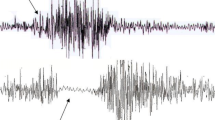Summary
It was demonstrated in this work that the complete isolation of the carotid sinus from the blood and the lymph circulation excludes the possibility of the reflex production of antibodies when the antigen acts on the glomus chemoreceptors alone. It was established by investigation of antigen resorption from the isolated carotid sinus by the leakage determination method that on the average about 24% of the antigen injected into the sinus is resorbed within the first 5 minutes. The determination of the antigen content in the sinocarotid nerve under these conditions demonstrated that one of the important paths of resorption was the perineural lymphatic spaces, and possibly the blood capillaries.
Similar content being viewed by others
Literature Cited
S. V. Anichkov, Fiziol. Zhur. SSSR 21, No. 1, 27–33 (1936).
A. N. Gordienko, The Neuroreflex Mechanism of Antibody Production and Regulation of Phagocytosis, Moscow (1954). In Russian.
P. F. Zdrodovskii, In book: Texts of Scientific Communications Presented at the 9th Session of the General Meeting of the AMN USSR, Moscow, 68–72 (1955) In Russian.
I. A. Oivin and Iu. V. Sergeev, Zhur. Mikrobiol., Epidemiol. i Immunobiol. No. 3, 98–102 (1956).
D. F. Pletsityi, Zhur. Mikrobiol., Epidemiol. i Immunobiol. No. 1, 129–136 (1957).
Iu. V. Sergeev, Diss. The Use of Radioactive Isotopes for the Experimental Study of Some Controversial Problems in the Mechanism of Sensitization and Antibody Production, Stalinabad (1956). In Russian.
M. Cohn and A. Pappenheimer, J. Immunol. v. 63, 291–312 (1949).
R. Doerr, In book: A. Bethe. Handbuch der normalen und pathologischen Physiologie, Berlin, Bd. 13, S. 650–812 (1929).
E. Friedberger, Huang, Ztschr. Immunitätsforsch. Bd. 39, S. 459–462 (1924).
E. Friedberger and K. Oshikawa, Ztschr. Immunitätsforsch. Bd. 22, S. 306–311 (1921).
E. Friedberger and M. Tinti, Ztschr. Immunitätsforsch. Bd. 39, S. 452–458 (1924).
E. Friedberger and T. Torii, Ztschr. Immunitätsforsch. Bd. 39, S. 462–468 (1924).
K. Geimans and D. Kordie, The Respiratory Center, Moscow (1940). In Russian.
R. Pfeiffer, cited by E. Friedberger and K. Oshikawa.
Author information
Authors and Affiliations
Rights and permissions
About this article
Cite this article
Ado, A.D., Ishimova, L.M. Concerning the reflex mechanism of antibody formation. Bull Exp Biol Med 46, 1305–1310 (1958). https://doi.org/10.1007/BF00845170
Received:
Issue Date:
DOI: https://doi.org/10.1007/BF00845170




